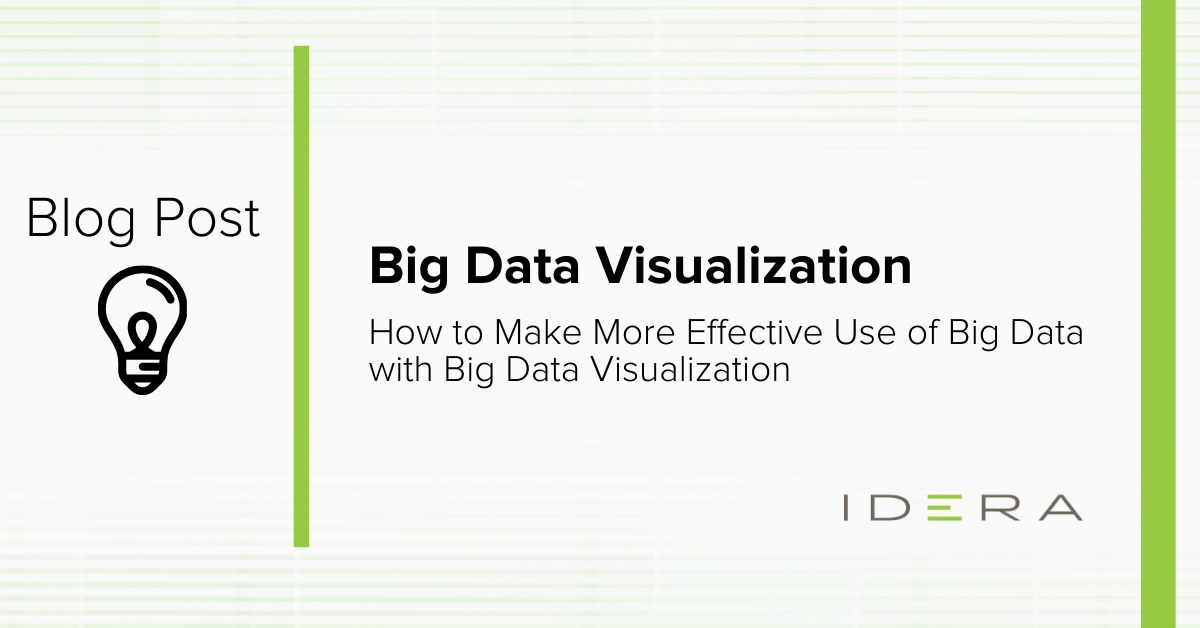Big data visualization describes the presentation of big data in various forms such as charts, graphs, and maps. It’s a necessary scaling up of the data visualization many are already familiar with.
With visualization, big data resources that are hard to understand can be transformed into an easily digestible form that is appropriate for all audiences in the enterprise. This means data stakeholders can more easily and quickly understand, interpret and communicate data including their trends and patterns.
One method of minimizing the challenges of using big data effectively is to employ visualization.

What is Big Data? (The Three Vs of Big Data)
The term big data refers to large, complex data sets that arrive from many diverse sources. Big data is defined by the three Vs.
Volume: The volume of information provided by big data can be impossible to process using traditional means. Companies often face hundreds of terabytes or petabytes of unstructured data of unknown value that need to be managed efficiently.
Velocity: The speed at which data is received, collected, and at times acted upon is another challenging aspect of big data. Sometimes, data captured from smart devices needs to be processed in real-time to be of use to an organization.
Variety: The variety of information streams also characterize big data. Both structured and unstructured data in the form of email, text messages, video, and audio are generated by many sources including social media feeds and mobile apps.
Big data offers organizations a tremendous amount of information concerning their customers, competitors, and market sector. Handling the three Vs effectively is essential for obtaining value to the enterprise from these voluminous and diverse data streams.
The volume of data can be overwhelming to assimilate and difficult to use productively. Failure to use the insights available in big data resources can leave a company at a distinct disadvantage compared to its rivals.
How a company processes and disseminates big data throughout the organization determines the probability that real value will be acquired from these resources.
Big Data Visualization Benefits
Big data can be extremely challenging to process and present in a form that enables it to be used productively. Big data visualization is a technique that can help minimize this challenge by presenting complex data streams in a more easily understandable format. In this way, the information can facilitate decision-making and produce value from big data.
Employing visualization to represent big data assets provides a business with multiple benefits.
- Information is understood more quickly and clearly through the use of data visualization techniques. This enables the data to be used to make timely decisions and constructively address issues and problems.
- Emerging trends are more readily identified with data visualization. Teams can act quickly to take advantage of market conditions that affect their business.
- Patterns and relationships hidden within big data resources become clearer when the information is presented visually. Identifying these patterns can help address issues or assist in finding new opportunities for the business.
- Visualization allows data to be analyzed at multiple levels of detail and from different perspectives. Dashboards and graphs can be configured to present an overview of the information for selected audiences. Teams can use the same visualization to drill down into the details when necessary.
- Sharing data with a diverse audience is one of the most powerful benefits of visualization. The process enables a story to be told that minimizes the complexities in the underlying data, making the information more valuable to decision-makers.
The key to getting the most value from big data resources is to use the right tools to create visualizations appropriate for the wider enterprise.
A Versatile Data Visualization Tool
Aqua Data Studio provides a versatile platform from which to create and share data visualizations from a wide range of sources. The tool is compatible with over 40 different relational and NoSQL database management systems (DBMS) including Oracle, SQL Server, Snowflake, MongoDB, and MySQL. The ability to access these diverse database platforms from a unified interface results in productivity gains and reduces the team’s learning curve while becoming proficient with the application.
Aqua Data Studio offers a flexible integrated development environment (IDE) that gives database administrators (DBAs) and developers the ability to manage systems and visually develop SQL code in addition to creating stunning visualizations of data resources. It can help teams handle the complexity of processing big data and uncover the valuable insights crucial for the success of data-driven companies.
This versatile tool furnishes teams with a wide range of analytical techniques with which to create the type of visualization needed to address specific big data resources. They include pivot tables, combination charts, and customizable dashboards. Workbooks and data extracts can be saved and shared with co-workers for more efficient interaction with the team.
With Aqua Data Studio, businesses can tame the complexity of handling big data resources by creating the right visualizations for the right audiences. It’s an impressive addition to the database team’s software toolbox that provides an excellent return on investment by identifying the value hidden in big data.